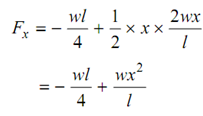Simply Supported Beam along a Triangular Load:
Simply Supported Beam along a Triangular Load Varying Gradually from Zero at both of the Ends to w per metre at the Centre
Let a simply supported beam AB of length l, subjected to a triangular load, varying slowly from zero at both of ends to w per unit length at centre as illustrated in Figure

Figure
As the load is symmetrical, thus, the reactions RA and RB shall be equal.
RA = RB = (1/2)´(1/2) × w × l = wl/4
Taking moments around A,

R B × l - (½) × w × l × (l/2) = 0
∴ R B =+ wl/4
RA =( ½) × w × l - RB = wl /2- wl /4= + wl/4
Let a section XX at a distance 'x' from the end B.
The shear force at XX,

F =-( wl/4) + (1 /2)× x × (2wx/ l)
=- wl /4 + wx2/l
SF at B,
FB =- wl/4 (at x = 0)
SF at C,
F B =- (wl/4) + (w/l).(1/2)2 ( at x = l/2)
=- (wl/4) + (wl/4) = 0
The shear force illustration is in the form of parabolic curve as the shear force equation is parabolic equation.
The bending moment at XX,
M x = (wl/4)x - (1/2) x × (2wx/l) × (x/3)
= (wl/4)x - (wx3)/3l
The BM at A & B is zero. The bending moment shall be maximum, where the SF changes sign. In this case, the maximum bending moment takes place at x = 1/2 , i.e. at C.
M max = M C = (wl/4)(l/2) -(w/3l)=(l/3)3
= wl2 /8 - wl2/24 = 2wl2/24 = + wl2/12
As, the bending moment equation is cubic equation, the bending moment diagram is in the form of cubic curve.